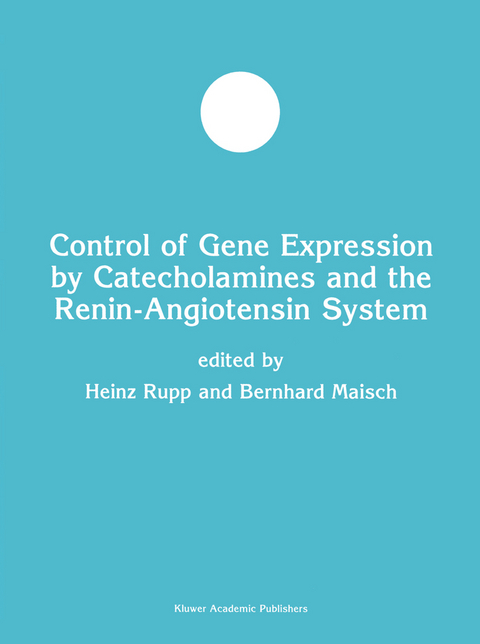
Control of Gene Expression by Catecholamines and the Renin-Angiotensin System
Springer-Verlag New York Inc.
978-1-4613-6955-4 (ISBN)
This focused issue is organized into chapters concentrating on catecholamines, angiotensin II, and the interaction between catecholamines and angiotensin II.
The special issue of Molecular and Cellular Biochemistry focuses on `Control of Gene Expression by Catecholamines and the Renin-Angiotensin System' in health and disease. In recent years, great progress has been made in the understanding of catecholamine and angiotensin II modulated gene expression. There is also increasing evidence that catecholamine and angiotensin II induced cellular injury not solely arises from classical pathways but also from a perturbed gene expression.
Taking into account that catecholamines and angiotensin II are vital for a balanced gene expression of many cells, the intriguing possibility arises that various disease are initiated or aggravated by such an imbalance. Catecholamine and angiotensin II influences can be in excess arising from, for example, hypercaloric food intake or psychosocial stress. During early progression of heart failure, sympathetic activity and angiotensin II influences also become increased. Due to beta-adrenergic receptor downregulation, depressed catecholamine influences are expected in the final stage of heart failure. An imbalanced influence of catecholamines and angiotensin II on gene expression leads to disordered molecular structures of the cell and an impaired cell function.
This focused issue is organized into chapters concentrating on catecholamines, angiotensin II, and the interaction between catecholamines and angiotensin II. Basic biochemical processes are covered in detail and the potential of these pathways for explaining chronic diseases associated with excess catecholamine and angiotensin II influences should become apparent. It is hoped that this focussed issue triggers novel research into the development of drugs that are targeted at diseases characterized by an imbalanced gene expression involving catecholamines and angiotensin II.
Mechanisms of transcriptional activation of cAMP-responsive element-binding protein CREB.- Transcriptional regulation by cAMP in the heart.- Regulation of tumor growth and metastasis of human melanoma by the CREB transcription factor family.- CRE-decoy oligonucleotide-inhibition of gene expression and tumor growth.- Attenuation of macrophage apoptosis by the cAMP-signaling system.- Catecholamines induce IL-10 release in patients suffering from acute myocardial infarction by transactivating its promoter in monocytic but not in T-cells.- Regulation of tyrosine hydroxylase gene transcription by the cAMP-signaling pathway: Involvement of multiple transcription factors.- Norepinephrine transporter expression and function in noradrenergic cell differentiation.- Catecholamines and angiotensinogen gene expression in kidney proximal tubular cells.- cAMP increases the expression of human angiotensinogen gene through a combination of cyclic AMP responsive element binding protein and a liver specific transcription factor.- The role of Ca2+ mobilization and heterotrimeric G protein activation in mediating tyrosine phosphorylation signaling patterns in vascular smooth muscle cells.- Functional cross-talk between the cyclic AMP and Jak/STAT signaling pathways in vascular smooth muscle cells.- The inducible cAMP early repressor ICERII? inhibits CREB and AP-1 transcription but not AT1 receptor gene expression in vascular smooth muscle cells.- Angiotensin II-induced changes in G-protein expression and resistance of renal microvessels in young genetically hypertensive rats.- Angiotensin receptor II is present in dopaminergic cell line of rat substantia nigra and it is down regulated by aminochrome.- Control of cardiomyocyte gene expression as drug target.- Designing antisense to inhibitthe renin-angiotensin system.- Angiotensin II induces gene transcription through cell-type-dependent effects on the nuclear factor-?B (NF-?B) transcription factor.- The role of Jak/STAT signaling in heart tissue renin-angiotensin system.- Rho plays an important role in angiotensin II-induced hypertrophic responses in cardiac myocytes.- Mechanisms of angiotensin II-induced platelet-derived growth factor gene expression.- Transactivation of EGF receptor induced by angiotensin II regulates fibronectin and TGF-? gene expression via transcriptional and post-transcriptional mechanisms.- Expression of renin-angiotensin system and extracellular matrix genes in cardiovascular cells and its regulation through AT1 receptor.- Regulation of angiotensin II receptors in the medullary thick ascending limb.- Bradykinin (B2) independent effect of captopril on the development of pressure overload cardiac hypertrophy.- Role of cardiac renin-angiotensin system in sarcoplasmic reticulum function and gene expression in the ischemic-reperfused heart.- Index to Volume 212.
| Reihe/Serie | Developments in Molecular and Cellular Biochemistry ; 33 |
|---|---|
| Zusatzinfo | V, 239 p. |
| Verlagsort | New York, NY |
| Sprache | englisch |
| Maße | 210 x 280 mm |
| Themenwelt | Naturwissenschaften ► Biologie ► Biochemie |
| ISBN-10 | 1-4613-6955-X / 146136955X |
| ISBN-13 | 978-1-4613-6955-4 / 9781461369554 |
| Zustand | Neuware |
| Haben Sie eine Frage zum Produkt? |
aus dem Bereich


